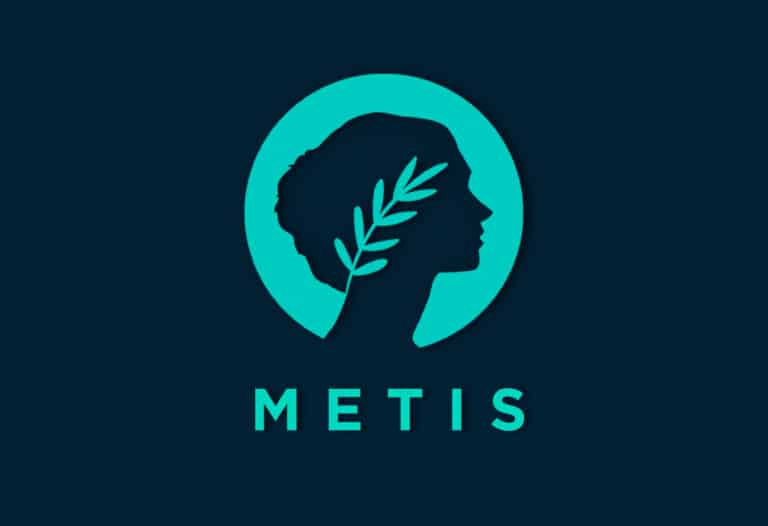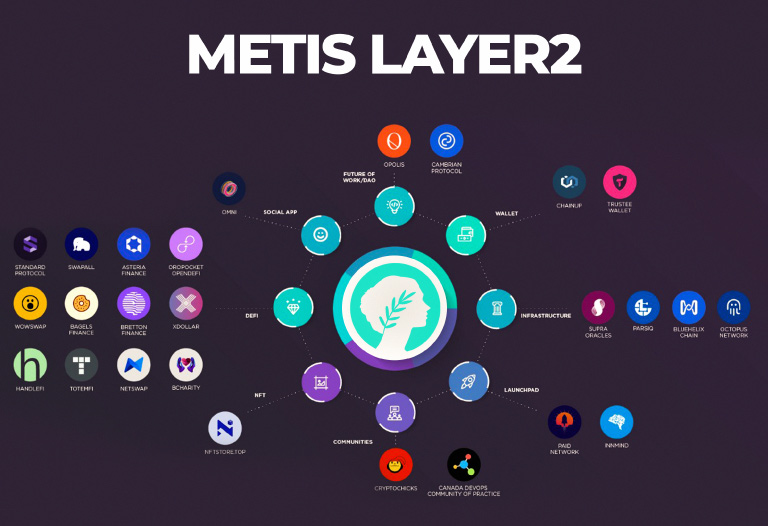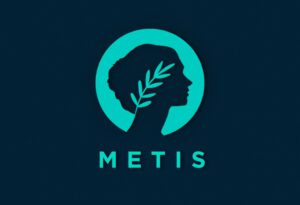
Table of Contents
ToggleOnly halfway through the second month, it is already clear that we are in the year of “the war of the second layer solutions” in Ethereum. And MetisDAO, intends to take a central role in this contest.
Freeing Ethereum’s core network from heavy computational work is the key to achieving scalability, cost-effective and instant transactions.
However, it goes without saying, this may not be the only goal that an L2 solution pursues. MetisDAO, endowed with a team of resonant names in the ecosystem, pursues a broader goal.
I invite you to learn more about this project and its objectives.
MetisDAO: an Ethereum L2
MetisDAO is a second layer solution, compatible with the Ethereum network, to which they intend to scale. But beyond the typical L2 solution proposals, from MetisDAO they set the goal of providing the infrastructure to migrate, as far as possible absolutely all, business models from Web2 to Web3.
The MetisDAO team, which includes Natalia Ameline, none other than Vitalik Buterin’s mother, has chosen to use the “Optimistic Rollups” technology to create its own second-layer solution.
So, let’s recap MetisDAO’s objectives:
-
- Create a scalability solution for the Ethereum core network.
- Migrating business models from Web2 to Web3
If you are a regular reader of this blog, you will already know what Ethereum network scalability today means. In a nutshell, a layer 2 seeks to relieve the heavy computational burden of transaction processing by performing them on an alternative network, enabling fast and inexpensive transactions.
However, it is with respect to the second objective that the greatest uncertainty may arise as to the means to achieve this end.
Therefore, let us first focus on analyzing the second point, and then continue with the first and unravel this ambitious project.
What are MetisDAO DACs?
These days, we are extremely familiar with the term DAO. These are Decentralized Autonomous Organizations, which are governed by their participants, who decide together the actions to be taken. In previous articles we have even explained how to create your own DAO.
However, from MetisDAO, they understand that this type of organizations, although they allow the management of the governance of a community, were conceived exclusively for “open-source” communities or projects.
It is in this sense that they decided to create a new concept to expand the capabilities of a DAO and efficiently address the management and incentives of autonomous and decentralized communities.
These are the DACs or Decentralized Autonomous Companies, which are a “sub-species” within the DAO “species”.
What are the characteristics that allow a DAC to better adapt to traditional business models?
When creating a DAC in MetisDAO, it will be assigned an Ethereum network address, and in it the members must deposit a share, which is called “Bond”, whose more accurate translation for the context, would be “linkage”.
In this way, DAC members would be financially linked to the project, which would tend to align incentives towards a common goal. Of course, any DAC member could lose part of his or her stake in the project if he or she withdraws from it.
Once this DAC has been created, its objectives have been aligned and the bonds have been staked, it is time to start working. Here, the work of MetisDAO stands out, providing a complete “off chain” service, connected to their L2 solution. In this way, proposals, votes, statistics and other records of the DAC were published in a transparent and accessible way for all its members.
Ultimately, the members of the DAC, according to their participation and their staking, mentioned at the beginning, will have a “Reputation Power” or, simply, reputation. It is evident that a higher PR means a higher level of involvement with the Company’s objectives. This facilitates the creation of effective and committed work teams.
With this simple but interesting set of tools, MetisDAO aims to achieve mass adoption of blockchain technology for traditional business models.

MetisDAO’s second layer solution
We know so far, that MetisDAO allows us to create or join an existing DAC, through simple steps to be performed on its website. Now, as a first goal, of this project we mention the need to scale Ethereum.
From the Ethereum Foundation, they are working on improvements to the network, whose major milestones are the “merge” or fusion of the PoW network with the PoS network and the sub-division of the main network into multiple different chains, by means of the sharding technique.
But these improvements will not be enough to make Ethereum scalable. What does scalable mean? It means that it can process a large number of transactions per second, that these transactions are economical and that all this happens without sacrificing any of the security that the network provides.
The best complement for Ethereum to achieve its long-awaited scalability then, are L2 solutions such as, for example, those of Loopring or Arbitrum, . As I already mentioned, from MetisDAO they created their own L2.
Let’s get to know what these solutions are all about, as we analyze Andromeda, MetisDAO’s second layer solution.
Andromeda, the L2 solution from MetisDAO
Like all second-layer solutions, when we talk about Andromeda we are referring to a blockchain that runs outside, “alongside” or at the side of a main network. Its objective is to free that main network, or L1 (Layer 1), from the heavy computational load required to process transactions.
Andromeda processes a large number of transactions per second and subsequently sends them to the Ethereum network for storage, in a single transaction.
How does this happen? Thanks to rollup technology. Within this type of solutions, we have two groups:
- zkRollups
- Optimistic Rollups
Today we will focus on the second group, the one chosen by Andromeda.
What are Rollups?
They are a technological solution, which allows Andromeda to process a large number of transactions that are then compressed to the maximum, in terms of the amount of information. This compression is performed up to the limits that allow validating whether a transaction is valid or not.
Then, once this process is done, all processed transactions are “wrapped” and sent to the Ethereum network as one. In this way, the security provided by the Ethereum network is not lost, but costs are lowered. Since the transaction fee in the main network is divided among all the transactions made, which can be up to a few thousand.
What are Optimistic Rollups?
As the name suggests, they are optimistic about the transactions they process. How does this translate in practice? Through this technology L2 transactions are processed by the sequencers and sent to the Ethereum mainnet assuming they are valid.
From that moment on, a period of 7 days, called the dispute period, is opened. During this period, any person who fulfills the role of verifier can “challenge” the validity of a transaction.
If the challenged transaction is valid, the challenger loses part of its guarantee, which it has deposited to fulfill this role, and the transaction is stored in the main network. In the opposite situation, the sequencer loses its guarantee and the transaction is reverted to the L2.
Benefits and disadvantages
At first glance, we can intuit that this dispute period of the Optimistic Rollups creates a big problem. When we want to withdraw funds from L2 to L1, we will have to wait for the dispute period. A situation we are not used to in this fast and decentralized world.
As an advantage, Optimistics Rollups technology enables the creation of L2 solutions that support multiple applications, for multiple purposes, today. We see this in examples such as MetisDAO, Optimistic and Arbitrum. While their rivals, zkRollups, still struggle with this possibility.
This is why Vitalik said “Optimistic Rollups will succeed in the short term, but in the long term zkRollups will be the ultimate solution to scale Ethereum.”

What else can we expect from Andromeda?
Beyond the technology that allows the Ethereum network to scale, when we talk about Andromeda we are talking about a framework that encompasses the following features:
-
- A multi-vm framework to support the scalability and security of the Metis Layer 2 infrastructure
- EVM equivalence, so that deploying applications to Andromeda does not require any adaptation of your code.
- Metis Explorer, a browser in which to check all network transactions
- Metis Bridge, the bridge to transfer tokens between Ethereum mainnet and Metis Layer 2, and in the future, NFTs.
- Polis is the site where users will be able to create or connect their wallets. Developers will also find support for managing their domains, smart contracts and APIs.
- Support for members of the DACs to perform staking
- A multi-vm framework to support the scalability and security of the Metis Layer 2 infrastructure
Andromeda and decentralization
The plan of this team is to go a step further in the decentralization of their L2. To this end, they plan to open the possibility for any user to join and become an Andromeda sequencer. In this way, they distance themselves from L2 projects with Optimistic Rollups, whose sequencers are centralized.
METIS, the MetisDAO token
Vital importance fulfills the token of this Ethereum scalability solution. Among its functions we find:
-
- Payment of transactions in Andromeda
- Escrow of both sequencers and verifiers
- Collateral currency of DAC members
- In-network investment incentive
- Payment of transactions in Andromeda
The growth of this token is closely related to the sustained growth of the DeFi ecosystem within the network. To get a sense of its magnitude, we can name as the latest guest to this ecosystem, none other than the Aave platform.
A look into the future
It is clear that MetisDAO, beyond an interesting team, has objectives focused on solving major drawbacks or shortcomings of the blockchain ecosystem.
A network capable of processing a large number of transactions per second in an economical and fast way, with the security of the Ethereum network, is the quest of every L2 project.
When it comes to mass adoption, countless initiatives focus their attention on users. However, few turn their attention to traditional business models and the facilitation of their integration into the blockchain world.
MetisDAO, combines both objectives, in a project that seeks to lead the space of L2 solutions. It will be a matter of time to know the final result…








